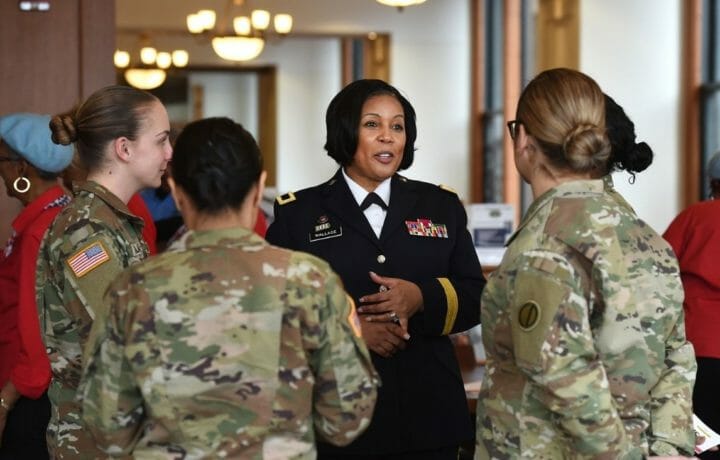On June 12, 1948, women were able to serve as regular members of the U.S. military. During World War II and past wars, women were able to serve in the military under various acts and programs that gave women the opportunity to fill roles that outside of wartime were not open to women. And while many women were unable to continue their service after the war’s end, a door was opened that allowed some women to continue to serve. This door was the Women’s Armed Service Integration Act. It changed the future for women today to be able to serve in every role in the U.S. Military. It is also why the date June 12 was identified to honor and recognize women veterans in 13 states across the country.
The Backbone of War Efforts
Many people do not know the history or role women have played in the U.S. military. Many believe that the first roles filled by women in the military were as nurses. But the truth is women have played a role in the military since the Revolutionary War. Women like Deborah Sampson would dress up as men to be able to fight for their country. Other women supported their husbands as either spies or even taking up arms if their spouse was injured or killed during battle. Women didn’t begin to serve in the role of nursing until the Civil War, and it wasn’t until the Spanish-American War in 1898 that the career field of nursing changed from being male-dominated to a female profession.
Women have been changing the role and future for military women for generations, and it is because of the roles women have stepped into that change for women in the military has happened. Let’s take a look at some of the stories that have changed the future of military women throughout history.
Nursing in the Military
Nursing started as a male-dominated field. At the time, nurses were known as stewards and since the trade was taught through apprenticeship, the opportunities for women to work in the field were few and far between. But Florence Nightingale of Great Britain served during the Crimean War and American Women heard the stories and wanted to do their part when the Civil War broke out in 1860. Women could attend basic schools to learn the trade of nursing, and while the Civil War opened the doors for women in nursing, most women did not continue in the field when they left the military. It wasn’t until 1898 that women could attend schools open to both men and women that the opportunity for nursing shifted with it becoming a predominately female field and an opportunity for women to serve in the U.S. military.
Women Spies
The history of women as spies also dates back to the Revolutionary War. Women were able to drift in and out of places unnoticed and pass along information to both the British and American forces. And while Harriet Tubman is most well known for her role in the Underground Railroad, she was also a spy for the Union. Passing along important information to help leaders plan attacks and know the strength of forces throughout the war. And women continued to fill the role of spy during WWII. Some of the most successful OSS agents during World War II were women. Virginia Hall (Goillot) was known as the limping lady and had a successful spy ring in Europe collecting vital information for the Allied Forces.
First Women Pilots
The first women pilots served during World War II, though they never received formal military status. Their role of ferrying aircraft, training male pilots, and towing targets was vital to the war effort. The effort to train women pilots was led by Jackie Cochran and Nancy Love. Unfortunately, because of political pressure with men returning home from war, the program Women Airforce Service Pilots (WASP) was disbanded, and women were not able to serve as pilots again until the 1970s.
In 1973, the first six women in the U.S. Navy were sworn in as pilots and began their careers. The book, Wings of Gold by Beverly Weintraub, follows the career of the first six women pilots covering highlights and challenges the women faced. In 1975, the Air Force and Army opened the doors for women pilots, and then by 1993, women could serve in combat aircraft.
Women in Combat Arms
In 1993 the role of women changed as women could serve both in combat aircraft and aboard combat Naval vessels. The first woman to serve as a fighter pilot was Maj Gen (ret) Jeannie Leavitt. She had completed pilot training before the law was changed and even though she finished at the top of her class, she could not pick the aircraft she wanted to fly, the F-15. The Air Force was aware of the change and had her work as a flight instructor and was ready to announce her as the first woman fighter pilot candidate when the law was changed in 1993.
The wars in Iraq and Afghanistan blurred enemy lines and also required a need for women to be embedded within combat units to help communicate and search for women from the local population. These women volunteered or were chosen to serve on these unique missions and showed that women were capable of performing ground combat operations. Because of their actions, women were allowed to serve in all aspects of the U.S. Military in 2015.
The role and history of military women is a fascinating one. Women today still face the challenge of being recognized for their service. While the narrative toward women and their service is changing in positive ways, having a day to highlight their service is a great way to honor their service and sacrifice.




